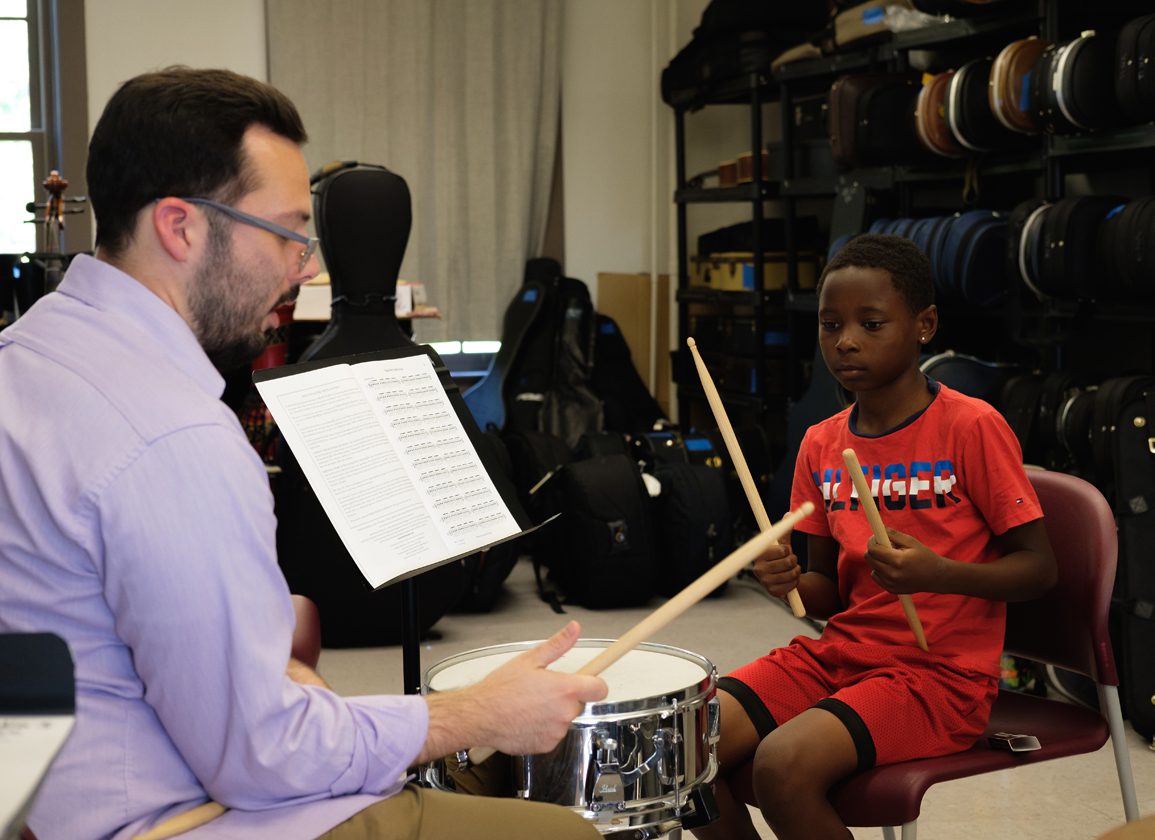This is the first in a new TDN series on people in the Thoroughbred industry who have a passion for a non-industry charity. Want to recommend someone for the series? Email katiepetrunyak@thetdn.com or suefinley@thetdn.com.
Dr. Scott Pierce has a lot to be proud of and even more to look forward to. The Rood and Riddle Equine Hospital partner and owner of Omega Farm is the breeder of MGISW Country Grammer (Tonalist), who is set to join the WinStar stallion roster this coming year. But if you caught Dr. Pierce bragging in between radiographs at this year's Keeneland September Sale, it probably wasn't about the first stallion to come off his boutique breeding operation. Instead, he was more than likely telling you about the Central Music Academy (CMA), a non-profit in Lexington that gives free musical training to students ages eight to eighteen who would not otherwise be able to afford professional musical instruction.
Pierce has been on the CMA's Board of Directors for nearly a decade and he has been the board's chairman since 2019. During that time, Pierce has been an outspoken advocate for the work being done through the organization.
“The bottom line is that it's all about the kids,” he shared. “It enables kids to receive really good, high-quality music lessons from very good teachers. It changes their lives; I've seen it happen.”
In 2015, a close friend asked Pierce if he would be interested in joining the CMA's Board of Directors. Knowing little about the organization, Pierce wasn't sure what to think of the commitment initially but he soon became hooked.
“So many people agree to be on different boards and you can either be an active or a passive board member,” he explained. “Seeing the change that this has made in these kids' lives has made me a very active board member and it's been a big part of my life for the past few years. When you see the difference it makes, it's easy to get involved and you want to promote it.”
Founded in 2004, the Central Music Academy started with just five students in its first semester and gradually built from 11 attendees to 20 and eventually to the current enrollment of about 100 students. Since its inception, it has provided over 50,000 free musical lessons in all areas of musical performance to more than 1,500 children. The students receive high-level instruction from teachers who hold Bachelor of Music degrees. Half of the teachers have also completed or are working on their master's or doctorate degree in music.
In order to qualify for the program, a family of four must make less than $60,400. This threshold is based off the U.S. Department of Housing and Urban Development's Lower-Income Household Levels.
“100% of the kids would not be able to afford this without aid,” Pierce said. “What's phenomenal is that CMA students have a 100% high school graduation rate and many of them go on to college. A lot of the students have also auditioned into SCAPA [Lexington's School for the Creative and Performing Arts] or have gotten into all-state bands or orchestras, so it helps them move along in their education and potential careers.”
One graduate of the program began taking trumpet lessons at CMA when he was 11 years old and went on to receive a scholarship at the University of Louisville, where he is now majoring in music education.
Pierce also pointed out the diversity of their students, noting that 42% are Hispanic, 40% African American and 15% Caucasian.
“The only thing that is discouraging is that there is always a waiting list,” he admitted. “There is not enough money to hire enough teachers. Currently there are 45 students on the waiting list because it is expensive to provide these free lessons.”
Growing up in Missouri, Pierce was never destined to become a musical genius. While his mother begged him to learn the piano, Pierce admitted that he “fought her tooth and nail.” Looking back now, Pierce realizes his childhood mistake.
“This is making up for some of the things I missed because I've learned as I've gotten older that music is so important in my life,” he said.
In addition to limited monetary resources, CMA has also had to overcome the obstacle of a restricted amount space to conduct their lessons. The program has bounced from one building to another over the past 20 years until this spring, when Pierce found a building for sale that would become the CMA's permanent home. Formerly the location of a prosthetics company, the 5,000 square foot building was the perfect fit with seven small rooms that were easy to renovate into private classrooms.
“One of my goals was to purchase a facility that we could call home,” Pierce said. “It's a blessing that we were able to afford it. We still have some renovations that we need to do, but this has been a huge deal for us and for the future. It gives the kids a fun, safe space to hang out and do their lessons.”
One of the eventual goals for the new facility is to convert the open basement into a space for recitals. Typically the CMA rents out event centers in Lexington to host multiple recitals and events each year, but a remodeled basement that could hold over 50 attendees would provide a built-in location for recitals as well as larger group classes.
While Pierce's major goal of finding a permanent location for the CMA has been fulfilled, he is far from taking the metaphorical foot off the gas pedal in terms of moving the organization forward.
“I don't want to see any kid on a waiting list,” he said. “That's the primary thing and then also to get more notoriety, get the mission out there. We know that the CMA is growing because we do get generous donations from people just out of the blue. I think knowing that it makes a huge difference in the kids' lives makes it an easy nonprofit to donate to.”
This year, Pierce's tenure as the CMA's chairman will come to a close. The program's Director Erin Walker Bliss said that Pierce's leadership over the past four years has been vital to the CMA's success.
“He's really excited about what CMA does and telling people about the program,” she said. “He's also excited about music. We were friends with him for years before he told us he had a cello in his closet that he had bought on a whim because he wanted to learn it. He's been a great voice for the organization and people take him seriously. Because he's a mover and a shaker in his own field, when someone is at that level it means that they're serious with anything that they're pursuing.”
Walker added that Pierce is now trying to recruit the next group of board members, perhaps even finding some music lovers from his circle of friends in the racing world.
“He has definitely helped spread the word throughout the horse industry,” she said. “We never had a connection to the equine industry before so it has brought in an entirely new group of supporters, which has been huge for us as well.”
Even when he is no longer on the nonprofit's board, Pierce has made it known to the CMA team that he isn't going anywhere.
“This has been truly fulfilling for me,” he reflected. “A lot of the kids know that I'm on the board and I've had some of them come up and thank me at recitals. To go down the hall and hear them in their lessons, I know it's really life changing for them.”
Pierce's involvement in the CMA is worlds away from his many achievements as an esteemed veterinarian and a successful breeder, but it holds an equally significant place in his heart.
“It's totally out of my wheelhouse, but it's been fun and rewarding,” he said. “I wish more people would get involved in things like this because it makes such a huge difference. I've been blessed to have many things come my way and it's a way to pay it forward, which I think there are a lot of people in the horse industry that do that. The generosity in the horse industry is phenomenal and I'm just a small part of it.”
Between his philanthropic endeavors, traveling far and wide for public auctions from Tattersalls to Ocala to Keeneland, and his managing shareholder position in Rood and Riddle's Wellington and Saratoga locations, Pierce shows no signs of slowing down.
“My goal 40 years ago was to breed racehorses and have a farm, so I'm living the dream,” he said. “You hear that a lot, but I truly am. I may slow down in terms of veterinary practice, but retire is not in my vocabulary.”
Click here to learn more about the Central Music Academy.
The post Giving Back: Dr. Scott Pierce and the Central Music Academy appeared first on TDN | Thoroughbred Daily News | Horse Racing News, Results and Video | Thoroughbred Breeding and Auctions.


